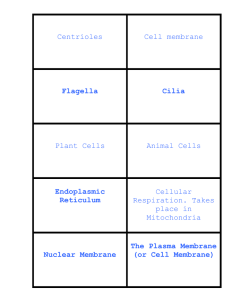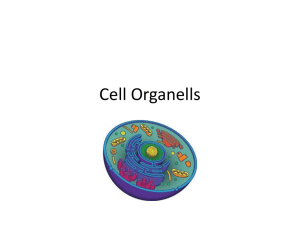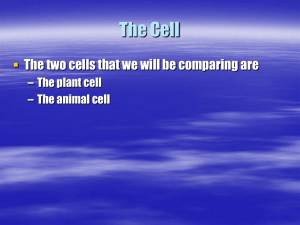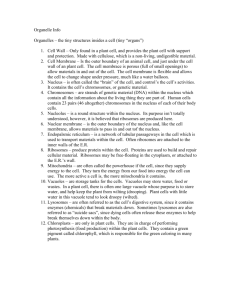Cell Structure and Function
advertisement
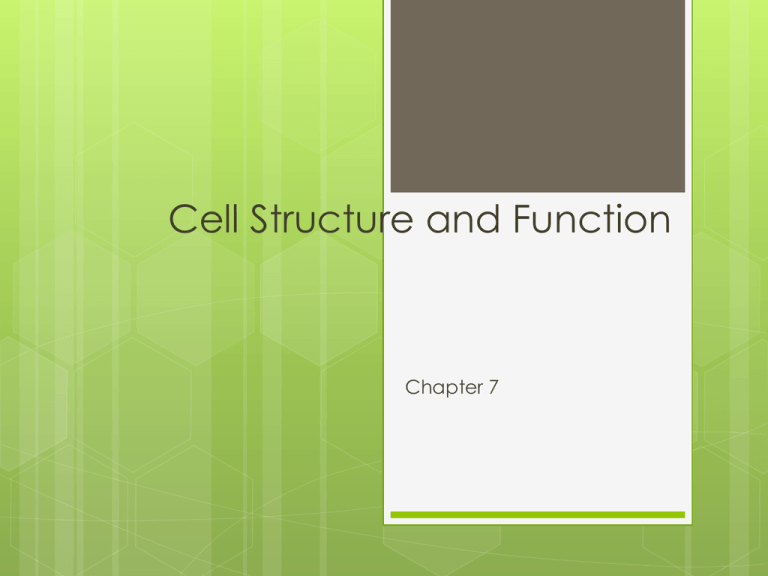
Cell Structure and Function Chapter 7 The discovery of cells Anton van Leewenhoek-given credit for inventing the first microscope Robert Hooke-first used the word cell He was looking at cork cells Robert Brown-discovered the nucleus Mathias Schleiden- all plants are made of cells Theodor Schwann-all animals are made from cells Rudolf Virchow-studied reproduction in cells and found all cells come from other cells Cell Theory all living things are made up of cells cells come from other cells cells are the basic unit of life There are 2 types of cells: prokaryotic and eukaryotic cells Prokaryotic cells-do not have a nucleus, the DNA is free in the cell. Prokaryotic cells are very small and do not have most cell structures. Example: bacteria cells Eukaryotic cells-contain a nucleus which holds the DNA together. They have many cell structures and are much larger cells. Example: all other cells (plants, animals, fungi) Major cell structures: Cell membrane-holds cell together, controls what enters and leaves made of 2 layers of lipids proteins embedded throughout Nucleus-means ”center”, usually appears darker, acts as control center surrounded by a nuclear envelope contains DNA which is our genetic information Cytoplasm-all the material between the cell membrane and the nucleus It is a jelly like material It holds all the cell organelles in place but still allows movement Cell wall-found in plants, most bacteria and fungi. Provides support and protection for the cell Made of cellulose (a combination of sugar and protein) Nucleolus-found ribosomes inside the nucleus, it makes the Cytoskeleton-framework support and strength microtubules-hollow inside cell for tubes made of protein, form the centrioles microfilaments-long thin fibers, movement and support cilia-short hair like structures on outside of cell for movement flagella-long hair like structures on outside of cell for movement Ribosomes-small proteins bead like structures that make may be free or attached to ER ER-endoplasmic reticulum-folded membrane forms a canal for materials to leave cell Smooth-no ribosomes attached Rough-has attached ribosomes Golgi apparatus-look like flattened sacs, modify and package materials to leave cell Lysosomes-small sacs with enzymes that digest food , foreign material or the entire cell when it wears out vacuoles-sacs that hold waste, food, water: storage centers plants have 1 large one in the center animals have several small ones Chloroplast-contain chlorophyll the green pigment produce sugar from sunlight found in plant cells only Mitochondria-power for energy certain house: breaks down food cells, like brain and muscle cells, may have thousands centriole-found only in animal cells, help the cell to divide, cell has two Plant cell Have a cell wall Have chloroplasts Do not have centrioles Have one large vacuole Do not have lysosomes Animal Cell Do not have a cell wall Do not have chloroplasts Have centrioles Have several small vacuoles Have lysosomes Movement through the cell membrane o o o o The environment of the cell is liquid inside and out. The liquid contains dissolved materials (solutes) These materials are always in motion This motion is random but follows the rule of moving from high to low concentrations. Methods of movement: o Passive-no energy is required by the cell. o o Diffusion-the random movement of materials from high to low concentration. It continues until equilibrium is reached Osmosis-the movement of water across a membrane from high to low concentration. Facilitated diffusion o carrier proteins found in the cell membrane transport material across the membrane o still moving from high to low Active transport o movement that requires energy o Endocytosis- moving material into the cell o phagocytosis- Greek for “eat”, cell engulfs large particles, vacuole forms around food o o o example- white blood cell eating bacteria in the body Pinocytosis- Greek for “drink”. The cell surrounds a large amount of water and forms a vacuole. Exocytosis-moving materials out of the cell o a vacuole moves to the cell membrane, it opens and material is pushed out Specialization of cells Unicellular organisms-the cell is the entire organism. It carries on all life functions. Multicellular organisms-cells are interdependent on each other. o They have specialized to do different jobs. Specialization-cells organism Examples1. 2. carry out different jobs for the Pancreas cells make the protein insulin so they have a lot of ribosomes and ER Respiratory cells have cilia and make mucus to keep foreign material out of lungs Levels of organization in multicellular organisms: cells muscle cell muscle cell tissue muscle tissue muscle tissue organ stomach heart system digestive circulatory



